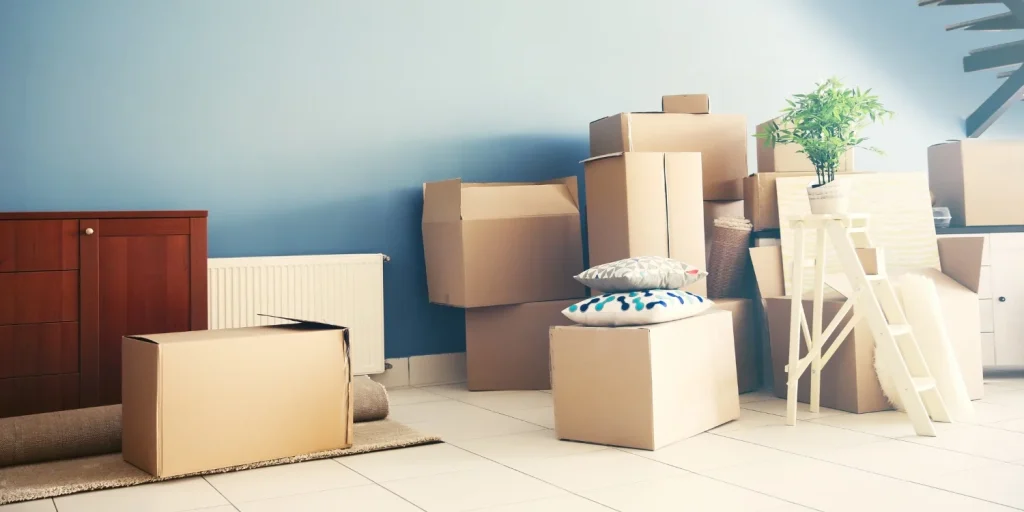Packing for a long-distance move can feel overwhelming, but don't worry - with the right approach, you can handle it like a pro. This guide will help you pack your house efficiently and keep your belongings safe during their journey to your new home.
Start Early
Packing for a long-distance move takes time, so start at least 6-8 weeks before your moving date. This early start ensures you'll have enough time to sort through your belongings, pack them carefully, and label everything without feeling stressed or rushed.
How to Plan
- Create a checklist: List all the rooms and areas you need to pack.
- Set a timeline: Dedicate specific days or weeks to certain rooms.
Declutter Before Packing
Long-distance moves typically charge by weight or volume, so the less you pack, the more money you'll save. Plus, decluttering before your move helps you avoid wasting time and energy packing items you don't really need anymore.
How to Declutter
- Sort items by category: Create piles for “keep,” “donate,” “sell” and “discard.”
- Be realistic: If you haven’t used an item in a year, consider letting it go.
Gather Packing Supplies
Good packing materials protect your items during the move. Invest in quality supplies to avoid damage.
Essentials
- Boxes: Use sturdy moving boxes in various sizes.
- Packing tape: Strong tape ensures boxes stay closed.
- Bubble wrap and packing paper: These provide cushioning for fragile items.
- Labels and markers: To label boxes by room and contents.
Pack Room by Room
Packing one room at a time keeps things organized and prevents confusion when unpacking.
Tips for Each Room
- Kitchen: Use dish packs or bubble wrap for fragile items like plates and glasses. Empty liquids and dispose of perishable food.
- Bedrooms: Pack clothes in wardrobe boxes. Use vacuum-seal bags for off-season items.
- Living Room: Wrap electronics in bubble wrap. Disassemble furniture and place screws or small parts in labeled plastic bags.
- Bathrooms: Pack toiletries in waterproof bags. Dispose of opened or expired products.
Label Everything Clearly
Clearly labeling boxes is essential for a successful long-distance move. Not only will it save you valuable time during unpacking, but it also ensures movers handle your belongings with appropriate care based on the contents of each box.
How to Label
- Write the room name and contents on each box.
- Mark boxes containing fragile items with “FRAGILE” in bold letters.
- Use color-coded labels for each room to make sorting easier.
Protect Fragile Items
Fragile items need extra care to prevent breakage.
How to Pack Fragile Items
- Wrap each item individually with bubble wrap or packing paper.
- Place heavier items at the bottom of the box and lighter items on top.
- Fill empty spaces with packing peanuts or crumpled paper to prevent shifting.
Pack an Essentials Box
An essentials box holds items you’ll need right away in your new home - think first-night necessities. Pack it last and keep it with you during the move instead of loading it onto the truck.
What to Include
- Toiletries
- A change of clothes for each family member
- Basic kitchen supplies (plates, utensils, a small pan)
- Chargers for electronics
- Important documents (passports, contracts, etc.)
Disassemble Furniture
Large furniture pieces need to be disassembled to fit in the moving truck and prevent damage.
How to Disassemble
- Remove legs from tables and chairs.
- Take apart bed frames.
- Wrap each piece with moving blankets to avoid scratches.
Take Special Care of Valuables
Keep valuable or irreplaceable items, like jewelry and important documents, with you during the move. Avoid packing these in the moving truck.
Hire Professional Packers (Optional)
If packing feels overwhelming, consider hiring professional packers. They have the expertise and supplies to pack efficiently and safely.
Benefits of Hiring Professionals
- Saves time and effort
- Ensures fragile items are packed securely
- Offers peace of mind for long-distance moves
Stay Organized on Moving Day
Moving day can be hectic, so staying organized is key.
Moving Day Tips
- Double-check that all boxes are sealed and labeled.
- Take photos of your items for insurance purposes.
Supervise the loading process to ensure boxes are handled carefully.

